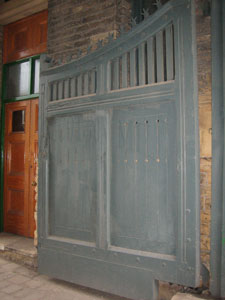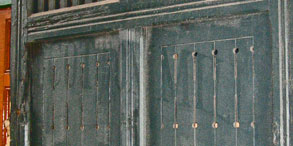North and South : Locations
'Marlborough Mills'
Four locations were used as Marlborough Mills. The exterior shots of the mill-yard and the Thorntons' house were filmed at Dalton Mills in Keighley. The interiors of the mill were filmed at Queen St Mill, Burnley, and at the Helmshore Mills Textile Museum, Rossendale. And the interior scenes in the Thorntons' house were filmed at a Georgian town-house in London. Elizabeth Gaskell, writing in the 1850s, described the Thorntons' house as having been built "some fifty or sixty years", so this house, dating from the 1790s, is actually closer in period than the building at Dalton Mills whose exterior we see in North and South. Two interconnecting rooms were transformed with heavy wallpaper, draperies and furniture into the Thorntons' mid-Victorian drawing room and dining room.
Dalton Mills, Keighley
The scenes in the mill-yard were filmed at Dalton Mills, on the eastern edge of Keighley, Yorkshire. Dalton Mills was actually a woollen mill, constructed from 1866 onwards.
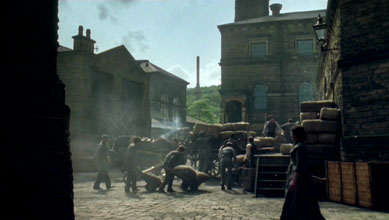 |
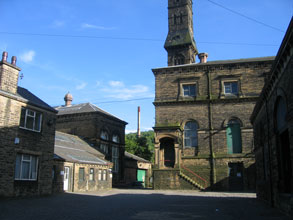 |
The view into the mill-yard from the gate. The chimney in the background to the left of the Thorntons' house is a modern metal one - it was replaced in post-production with an old brick chimney. On the left of the mill-yard can be seen the facade that was erected to cover up a twentieth century building. The building chosen to be the Thorntons' house was in fact an engine house. The top two floors are actually one big room, built to house a pair of 500hp beam engines. At the time they were the largest, most powerful stationary steam engines in the United Kingdom, possibly the world. But in 1904, a broken shaft rolled into the rotating flywheel and the engines were destroyed. The building in the right foreground is also an engine house. |
|
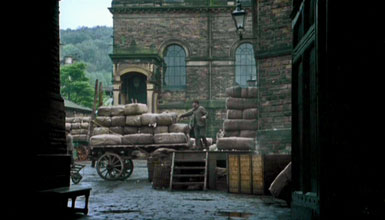 |
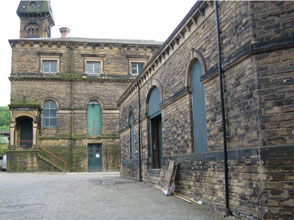 |
| The loading door on the middle floor was replaced with a window for filming, and the railings by the steps from the 'front door' were removed (no Health and Safety regulations in mid-Victorian England!). The only scene filmed inside this building was the short conversation between Margaret and Thornton at the window as the rioters poured into the mill-yard. Other scenes in the Thorntons' house were filmed in London. | |
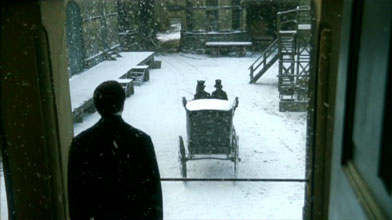 |
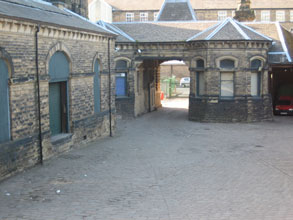 |
The view from the Thorntons' house across the mill-yard to the gate. The little building to the right of the gate was the Manager's Office. The windows on all sides allowed the manager a good view of the comings and goings in the yard. Three scenes were shot there. |
|
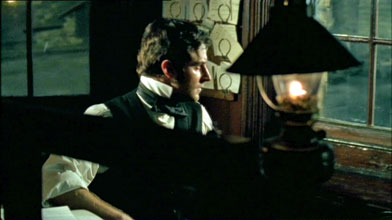 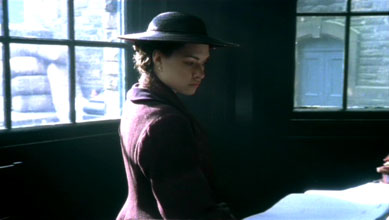 |
|
| In one scene, John Thornton looks out at little Tom Boucher in the mill-yard late at night. Margaret waits in the same office when she first visits Marlborough Mills to see Thornton. The scene after the riot in which Thornton speaks to the police officer was also filmed in the Manager's Office. | |
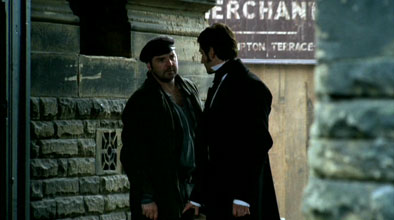 |
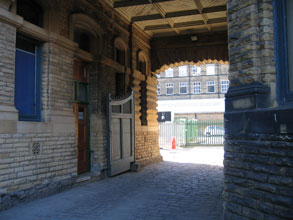 |
| The view out through the gate is of industrial buildings on the other side of Dalton Lane. This was covered up for filming with some suitably dressed hoardings. | |
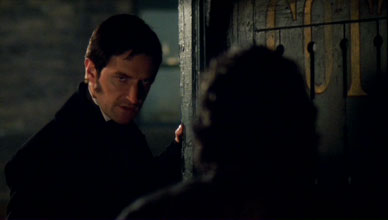 |
|
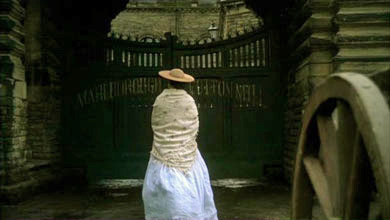 |
|
The gates to 'Marlborough Mills'. The words "Marlborough Cotton Mills" were painted across the gates. Although they have since been painted over, the ghost of the words remains, as can be seen in the slightly enhanced photo on the lower right. |
|
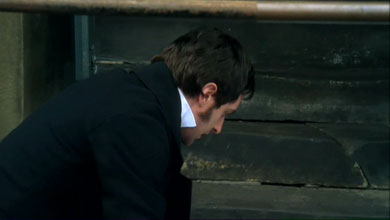 |
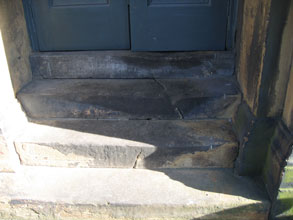 |
| The steps to the Thorntons' house - John Thornton tends to Margaret after she has been hit by a stone during the riot. | |
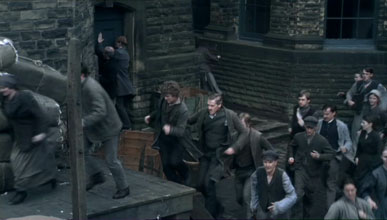 |
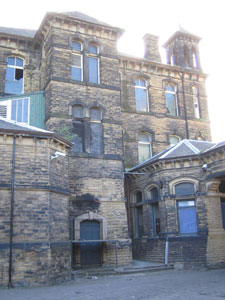 |
| The rioters attempt to break down the door to the mill to find the Irish workers. The doors here lead in to the largest of the mills in the Dalton Mills complex, Genappe Mill (see photo further down). | |
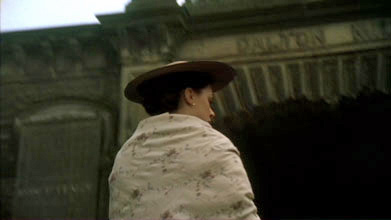 |
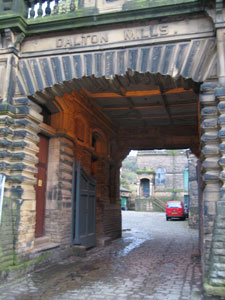 |
A shot of Margaret entering the mill before the riot briefly gives away the true location of 'Marlborough Mills'! |
|
Richard Armitage said of the filming here, "A really important moment for me was when we arrived in Keighley, which was about three weeks into filming, and I finally saw the mill. This is his empire and it had a profound effect on me which I wasn’t actually aware of at the time, but I grew about two inches, I think." [1] It may not be clear from the scenes we see in North and South just how impressive in size the mill is. In the drama, we only see the mill-yard, but the mill complex is in fact much larger, consisting of several separate mills. These two photographs give some idea of the scale of Dalton Mills.
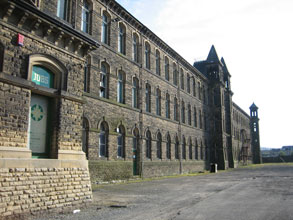 |
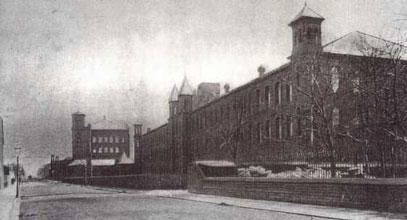 |
| The front of the Dalton Mills complex, showing Genappe Mill. | A late nineteenth century view of Dalton Mills. |
There is another mill the same size as Genappe Mill behind it and running roughly parallel with it, called New Mill. And to the left of the gateway as you enter the mill-yard is Tower Mill, the building that can be seen in the distance in the photograph on the right. Tower Shed lies along the left hand side of the mill-yard as you enter it.
Dalton Mills was still operating as a mill into the 1980s, albeit on a very reduced scale. It was sold in 1991. The buildings around the mill yard have been used by small businesses for several years, but the rest of the mill has been neglected.
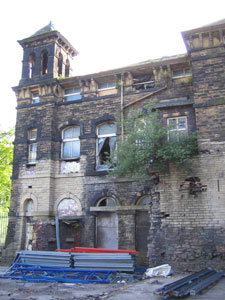 |
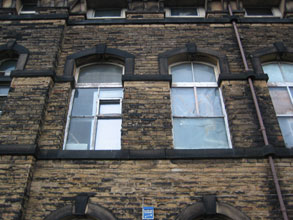 |
The whole mill complex is now being renovated and will be used partly for light industry and partly for homes. Even the stonework, grimy from decades of smoke, has now been cleaned.
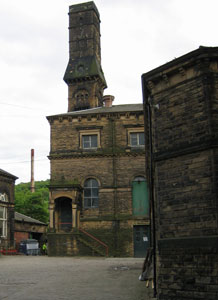 |
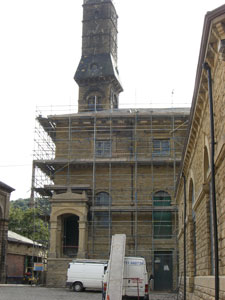 |
Before cleaning. |
After cleaning. |
The BBC now has a studio at Dalton Mills. In autumn 2008, BBC One's magazine programme, Sunday Life was broadcast live from the studio each Sunday morning, with the mill-yard also being used for some parts of the programme.
On New Year's Day 2011, a major fire broke out at Dalton Mills, resulting in the collapse of part of one of the mills. The area around the mill-yard, as seen on North and South, survived the fire. News reports from BBC News, Keighley News and the Bradford Telegraph and Argus describe the fire.
Queen St Mill, Burnley
Queen St mill was one of a number of mills in the Harle Syke area of Burnley. It was used for the scenes in the weaving shed at 'Marlborough Mills' - for example, when we first see John Thornton looking out over his workers, and when he stands in his empty mill after it has closed, talking to Higgins and little Tom Boucher. Queen St was a weaving mill, with this one large weaving shed and some ancilliary areas. It was built in 1894 as a workers' co-operative.
| |
|
| The weaving shed currently holds over 300 weaving looms. But it was originally three times as large, and at one time over 1000 looms were in use. | |
| Conrad Varley tends the weaving looms, and appeared in North and South as an extra - he can be seen on the left in the screen-capture. The other 'weavers' are just actors, trying to look as if they know what they're doing! | |
The rows of looms are tightly packed into the weaving shed, but there is one wider alleyway. This is where the wooden platform on which we first see John Thornton was constructed. The two photographs below right show this. The first was taken during filming and is on display at the mill. The one below it shows this part of the weaving shed as it normally is. The electric light shades were removed throughout the shed during filming, although the vertical pipes that carry the cables down to the lights are still visible. (Those who know Life on Mars may recognise that the interior scenes of the mill in episode 3 of series 1 were also filmed here. The body was found in this alleyway between the looms.) |
|
| In this scene, John Thornton is chasing one of his workers, whom he has caught smoking in the mill. The risk of fire in cotton mills was very real and smoking was normally banned. A major fire at Queen St in 1918 damaged a large part of the mill. But the weaving shed survived unscathed, so the looms we see today are the originals from the 1890s. | |
This photograph, on display at the mill, shows the conditions the actors and crew had to work under while filming North and South at Queen St. Snow candles were used to create the cotton fluff, though in a weaving shed there wouldn't actually have been much fluff in the air. As well as the 'cotton fluff' there was the noise to contend with. The noise of the overhead line-shafting driving the weaving looms, together with the looms themselves, is deafening and speech is almost impossible to hear. |
|
| One of the props brought in by the BBC to dress the mill for filming was a large bale of cotton, seen in the centre of the photograph on the right. It was left at the mill after filming and was on display for quite some time afterwards. | |
Queen St Mill ceased production in 1982, but was re-opened as a museum in 1986. Now owned and run by Lancashire County Council, it concentrates on telling the story of cotton weaving. As well as the main weaving shed, other areas are open to the public and show a variety of weaving looms. The mill is well worth visiting and complements Helmshore Mills Textile Museum, which is also owned and run by Lancashire County Council (see below). Helmshore spins the cotton that is then sent to Queen St to be woven. Goods made from the resulting cloth are on sale in the shops at both museums. |
|
Helmshore Mills Textile Museum, Rossendale
Other scenes of the interior of 'Marlborough Mills' were filmed in Whitaker's Mill, one of two mills that form the Helmshore Mills Textile Museum. The older of the two mills, Higher Mill, was built in 1789 for fulling woollen cloth. Whitaker's Mill was used for spinning waste cotton - it produced a soft, coarse thread suitable for flannelette, dishcloths etc.
On the first floor of Whitaker's Mill is the large spinning room, containing condenser spinning mules that date from 1903. They're still used to demonstrate the spinning process to visitors, and to produce thread that is sent to Queen St to be woven. Several scenes were filmed here.
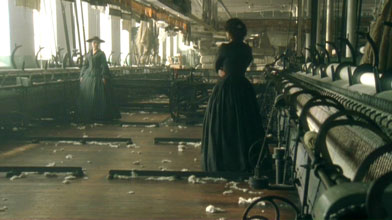 |
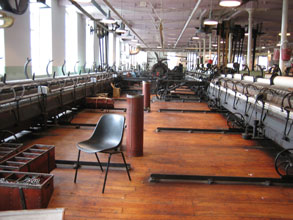 |
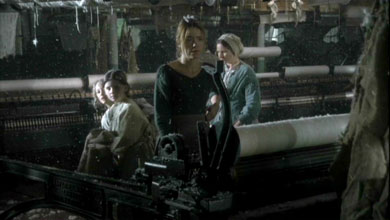 |
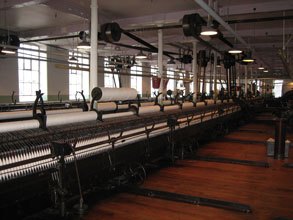 |
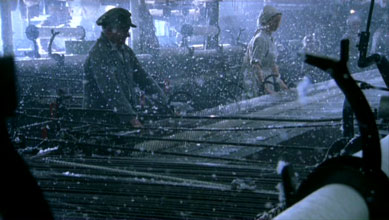 |
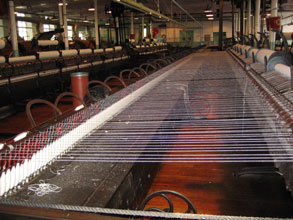 |
A few steps above the spinning room, and looking out over it, is the Carders' Cabin. Three scenes set in John Thornton's office were filmed here. (The shots of him looking out onto the mill-yard late at night were filmed at Dalton Mills, as explained above.)
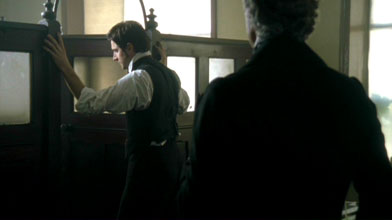 |
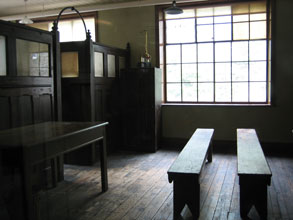 |
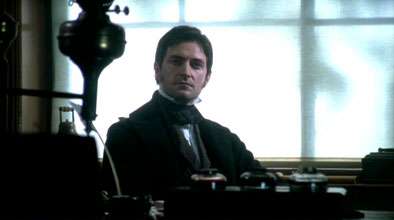 |
|
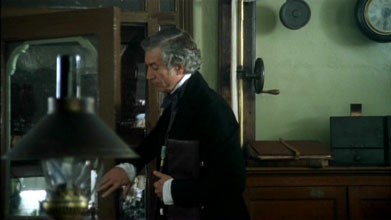 |
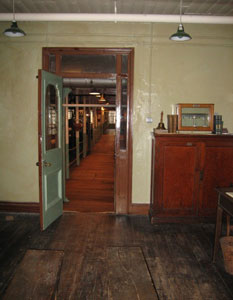 |
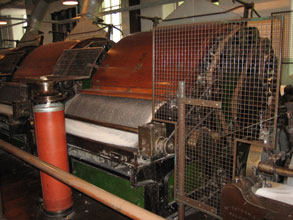 |
The Carders' Cabin gets its name from the carding engines that are also to be found in the spinning room - they're on the right as you leave the office. They, and other nearby machines, process the cotton so that it's ready to be spun on the mules. |
With windows all round, the spinning room is actually quite light. To make it look darker for filming, dozens of heddles were brought over from Queen St mill and hung from the ceiling. (Heddles are used on a weaving loom - the warp threads are threaded though them so that alternate threads can be lifted up to allow the shuttle to pass between them.)
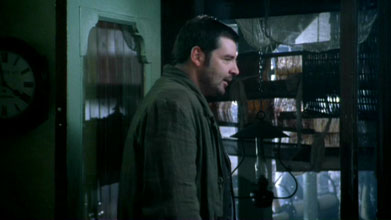 |
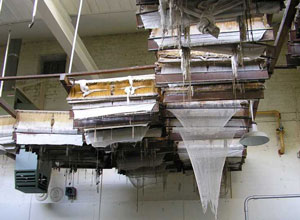 |
The picture on the left shows the view from the Carders' Cabin (Thornton's office) out over the spinning room, and the heddles can be seen hanging from the ceiling. They can also be seen in the picture of Mrs Thornton and Margaret in the empty spinning room, further up the page. The photograph on the right shows the heddles hanging up at Queen St mill where they're usually kept.
Below the spinning floor is the Devil Hole, a passage used for storing and packing. Conditions here would have been hellish; the cotton bales were unpacked and the cotton blended before being sent upstairs to the carding engines. Of all the parts of the mill, this is the one that would have been full of cotton fluff floating in the air. Margaret is seen walking along this corridor on her first visit to the mill.
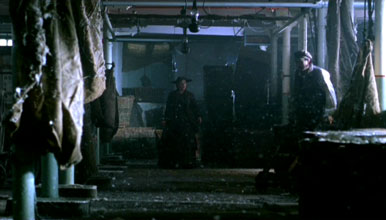 |
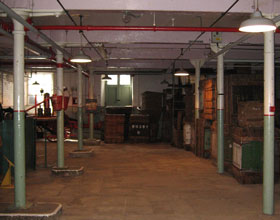 |
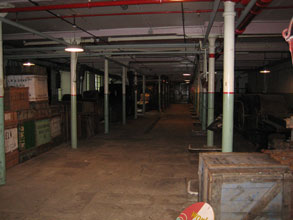 |
Margaret's view down the passage. At the end is a door which she slides back and walks through - into the weaving shed at Queen St Mill several miles away! The door at the end of this passage is too modern and wasn't used in the filming. A more suitable door was constructed at Queen St. |
Helmshore, like Queen St, is open to the public. Machinery on display at the museum includes Arkwright's water frame and Hargreaves' spinning jenny, two spinning machines that were the precursors of Samuel Crompton's spinning mules that we see in the spinning room of Whitaker's Mill today. The old machinery for fulling woollen cloth can also be seen, as can the water wheel that used to power Higher Mill. Helmshore and Queen St mills are just a dozen miles apart, and can easily be visited in a single day. Together, they tell the story of cotton manufacture in Lancashire. |
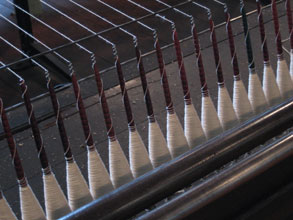 |
Locations Introduction | Pictures of the London locations
Links
Queen St Mill, Burnley
Helmshore Mills Textile Museum
Source
[1] Interview with Richard Armitage on the North and South DVD.
Pictures episode 1, episode 2, episode 3, episode 4 | Locations | Production details and DVDs

